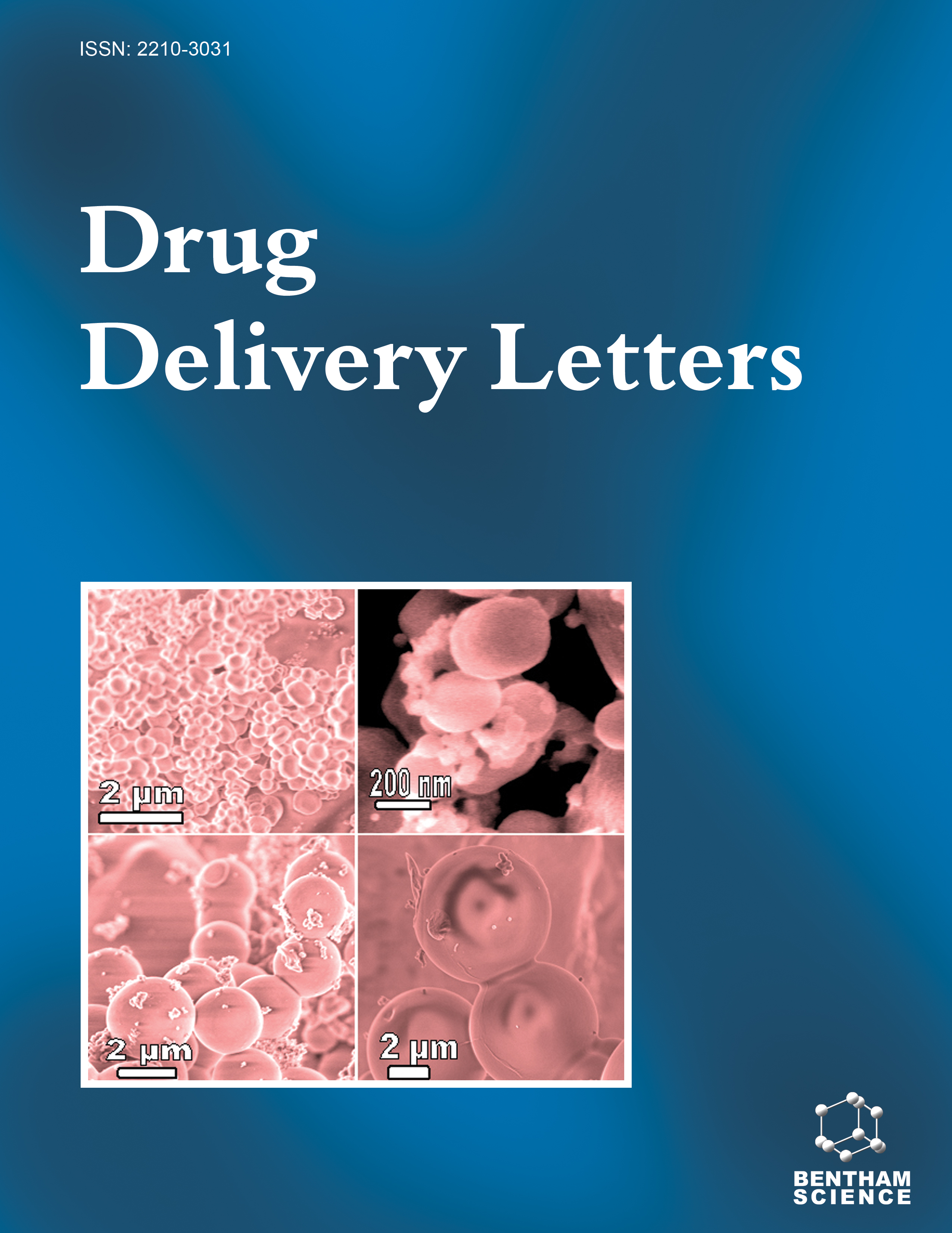- Home
- A-Z Publications
- Drug Delivery Letters
- Previous Issues
- Volume 10, Issue 3, 2020
Drug Delivery Letters - Volume 10, Issue 3, 2020
Volume 10, Issue 3, 2020
-
-
Pharmaceutical Co-Crystals - Design, Development and Applications
More LessAuthors: Rachna Anand, Arun Kumar and Arun NandaBackground: Solubility and dissolution profile are the major factors which directly affect the biological activity of a drug and these factors are governed by the physicochemical properties of the drug. Crystal engineering is a newer and promising approach to improve physicochemical characteristics of a drug without any change in its pharmacological action through a selection of a wide range of easily available crystal Read More
-
-
-
Functionally Tailored Electro-Sensitive Poly(Acrylamide)-g-Pectin Copolymer Hydrogel for Transdermal Drug Delivery Application: Synthesis, Characterization, In-vitro and Ex-vivo Evaluation
More LessBackground: To develop electro-sensitive transdermal drug delivery systems (ETDDS) using polyacrylamide-grafted-pectin (PAAm-g-PCT) copolymer hydrogel for rivastigmine delivery. Methods: Free radical polymerization and alkaline hydrolysis technique was employed to synthesize PAAm-g-PCT copolymer hydrogel. The PAAm-g-PCT copolymeric hydrogel was used as a reservoir and cross-linked blend films of PCT and poly(vinyl a Read More
-
-
-
Microfluidic Manufacture of Solid Lipid Nanoparticles: A Case Study on Tristearin-Based Systems
More LessAuthors: Giulia Anderluzzi and Yvonne PerrieBackground: Solid lipid nanoparticles are lipid-based carriers that can be used for a range of drugs and biomolecules. However, most production methods currently used do not offer easy translation from laboratory preparation to scale-independent production. Objectives: Within this study, we have investigated the use of microfluidics to produce solid lipid nanoparticles and investigated their protein loading capability. In the dev Read More
-
-
-
Solubility-Permeability Interplay of Hydrotropic Solubilization Using Response Surface Methodology
More LessAuthors: Nidhi Nainwal, Sunil Jawala, Ranjit Singh and Vikas A. SaharanBackground: The solubility/dissolution of a drug in the gastrointestinal (GI) region and the permeability of a drug through the GI membrane are the two key parameters governing drug absorption. Poor aqueous solubility is the rate-limiting factor for the absorption of poorly soluble drugs through the GI region. Objective: The purpose of this work is to investigate the influence of two different hydrotropes, namely sodium benzoate ( Read More
-
-
-
Dry Emulsions based on Alpha Cyclodextrin and Vegetable Oils for Buccal Delivery of Lipophilic Drugs
More LessBackground: Buccal delivery of drugs can be used as an alternative administration route to conventional oral route avoiding the liver first-pass effect and improving patient compliance. Objective: The goal of this work was to develop dry emulsions for buccal delivery of ketoprofen, used as a lipophilic model drug. The influence of two vegetable oils, olive oil or wheat germ oil, in the presence of α-cyclodextrin and different dryi Read More
-
-
-
Alpha Tocopherol Loaded in Liposome: Preparation, Optimization, Characterization and Sperm Motility Protection
More LessAuthors: Lamia Taouzinet, Sofiane Fatmi, Allaeddine Khellouf, Mohamed Skiba and Mokrane Iguer-ouadaBackground: Alpha-tocopherol is a potent antioxidant involved in sperm protection particularly during cryopreservation. However, its poor solubility limits the optimal protection in aqueous solutions. Objective: The aim of this study was to enhance the solubility of α-tocopherol by the use of liposomes. Methods: The experimental approach included loading vitamin E in liposomes prepared by ethanol injection method and the Read More
-
-
-
3 (2) Factorial Design Assisted Crushed Puffed Rice-HPMC-Chitosan based Hydrodynamically Balanced System of Metoprolol Succinate
More LessAuthors: Shashank Soni, Veerma Ram and Anurag VermaIntroduction: Hydrodynamically balanced system (HBS) possesses prolonged and continuous delivery of the drug to the gastrointestinal tract which improves the rate and extent of medications that have a narrow absorption window. The objective of this work was to develop a Hydrodynamically Balanced System (HBS) of Metoprolol Succinate (MS) as a model drug for sustained stomach specific delivery. Methods: Experimental ba Read More
-
-
-
X-ray Powder Diffraction Spectroscopy as a Robust Tool in Early Predicting Bioavailability of Pharmaceutical Formulation Containing Polymorphic Drug Substance
More LessAuthors: Abhishesh K. Mehata, Deepa Dehari, Senthil R. Ayyannan and Madaswamy S. MuthuX-ray powder diffraction (XRPD) is a unique, solid-state analytical tool used to study the 3D structure of small or macromolecules by their x-ray diffraction or scattering patterns. X-ray diffraction by a crystal reflects the periodicity of crystal architecture; any imperfections within the crystal architecture can be easily identified by its poor diffraction pattern. Recently, an open crystallography database reported that more than Read More
-
Volumes & issues
Most Read This Month
Article
content/journals/ddl
Journal
10
5
false
en


